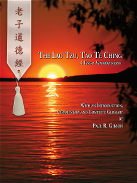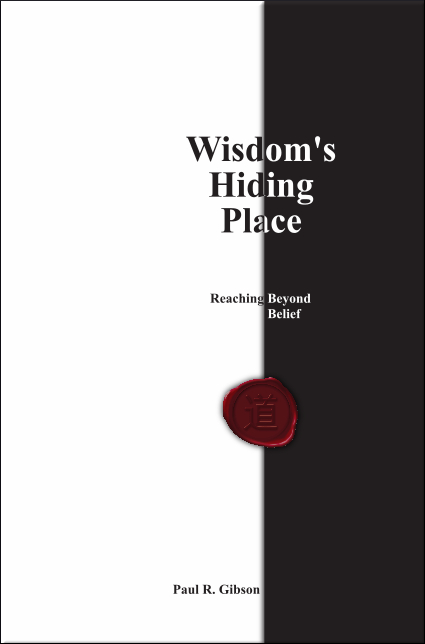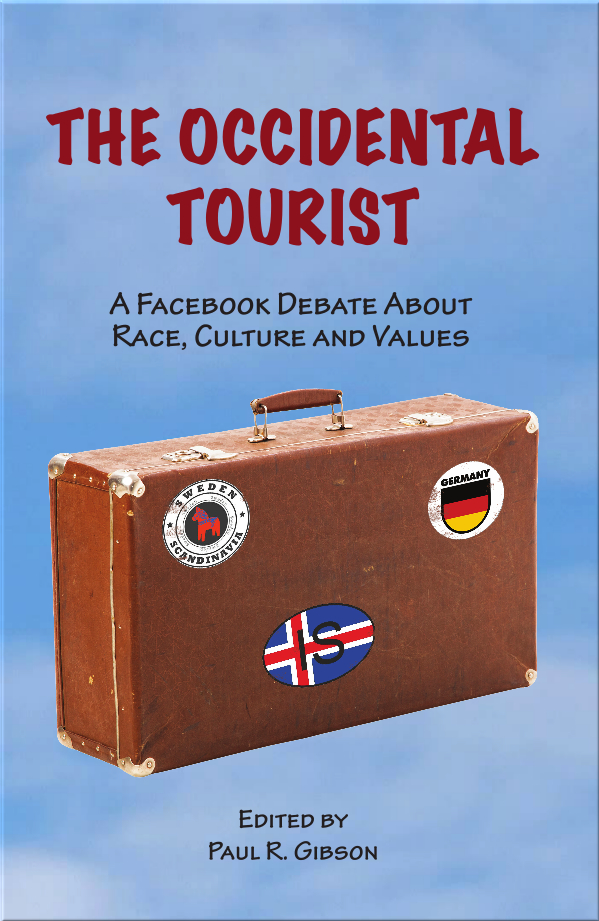Buy Now at Amazon
Barnes & Noble

E-book available on Amazon,
B&N,
Google Play

Score
Books
More books by
Paul R. Gibson



Introduction Historically there have been three main religious/philosophical traditions in Chinese culture: Buddhism, Confucianism and Taoism. Many people in the West are familiar with the Buddha and Confucius, but a surprising number are still unfamiliar with the main document that underlies Taoism, the Lao Tzu (Laozi), or as it is commonly known today, the Tao Te Ching (Daodejing); yet it is one of the most translated books in history. So, why this interpretation and commentary? Because I want to illustrate the depth, subtlety and richness of the language and philosophy by explaining the visuals provided by key Chinese characters and the pictograms that precede them. Road to Road, very Avenue.
The Tao Te Ching is very short and is written in Chinese characters (this version is 5,269 characters—approximately 797 of them unique) known technically as logograms and ideograms. These characters can provide many interpretive insights that singular word replacements can’t. They often consist of compound diagrams consisting of one or more root components. The primary root components are called radicals. Alone and more often combined, these components form the painted word. Instead of being geared toward a word-for-word translation, these characters offer up clues within the pictures they paint; and a picture is worth ten thousand words. Even when my words are similar to those of other translations, within my commentary I’ll expound upon the construction and meaning of various characters so you can see how and why my interpretation may differ at times.
Even if a translation appears fairly straightforward, all interpretation is subjective; it must be. Just as every translator interprets, every reader brings his or her abilities to understanding (interpreting) what they read. So it is, will be, and always has been, you will interpret what I have interpreted. Valuing this tendency rather than fighting that which is natural, I intend to offer up ways of seeing the text: Together we will re-view the text through its images rather than hearing only the words as traditionally translated. Since there is no way to translate without interpretation, what follows are several “literal” examples of Chapter 1. (Rather than top to bottom, right to left, I’ve formatted the text below in a modern left to right style.)
名可名, 非常名.
無名,萬物之始,
有名,萬物之母.
故,常無欲
以觀其妙.
常有
欲以觀其徼.
兩者同出而異名.
同謂之玄,
玄之 又玄,
衆妙之門.
Here is a translation of the text by way of Google Translate 2014:
Name that can be named very name.
Unnamed, beginning of all things,
Famous, mother of all things.
Therefore, often desire
In view of its wonderful.
Often I want
To watch go around.
Both but with a different name.
With that of the mysterious,
Metaphysics and mysterious,
All the wonderful door.
Now, this may be a literal translation, but it is not very helpful to our understanding. It lacks any context, whether visual, historical, philosophical or otherwise.
For those interested in rhyme and how the characters might sound, we now look at the Wade-Giles romanization. A romanization is an English construction that replaces Chinese characters with spelled out words so as to bear some semblance to how they might sound when spoken:
Tao k'o Tao, fei ch'ang Tao.
Ming k'o ming, fei ch'ang ming.
Wu ming, wan wu chih shih.
Yu ming, wan wu chih mu.
Ku ch'ang wu yü,
Yi kuan ch'i miao.
Ch'ang yu yü
Yi kuan ch'i chiao.
Tz'u liang chê t'ung, ch'u erh yi ming.
T'ung wei chih hsüan,
Hsüan chih yu hsüan,
Chung miao chih mên.
Keeping some traditional, historic and philosophical context in mind, here is a helpful example:
Tao able to be Tao’d, opposes unchanging Tao.
Name able to be named, opposes unchanging name.
Non-being, names ten thousand things its origin.
Being, names ten thousand things its mother.
Therefore by unchanging non-being,
Desire follows from true sight of its essence.
Desire then sees its appearance.
Both but with a different name,
In unity it is called dark;
Dark again it is dark,
All essence its entrance.
Although a word-for-word translation/interpretation like this can be quite helpful, as any interpretation becomes further removed from the source images, we do well to consider what we might be missing. Because my own interpretation is quite literal, at times it might sound terse or clunky, but I think it’s important to try to render the text as it seems to be written. Any aid and clarification that I think might help will be accomplished, I hope, within my commentary.
Using information provided by the characters, and by delving deeper into the underlying philosophy, I hope to add some color to meaning that might otherwise be too black and white or obscure. English speakers are so accustomed to expect word-for-word translations, we forget, or might not be aware of, the picture the characters paint. They encompass images and offer context far beyond that of the basic word/phrase replacements that I use prior to my commentary.
Today, like any other age, there can be a wide gulf between formal language and common usage. Many of us may understand much formal and common usage, but we may sometimes be too far removed from today’s popular sayings to have necessary comprehension. We then have rhyme that often leads the author to curious character choices and their ordering. Moreover we have the color and complexities that arise from “wordplay” like puns. Furthermore there is very little punctuation, as we know it, within the text. Beyond this, the style is rooted in paradox and is sometimes cryptic due to the nature of its subject matter. Often we must go back in time and rely upon ancient commentaries in order to glimpse context and thus glean value from the text. Therefore, I am so indebted to these commentaries that this work is hardly my own.
The reader should know that there are a number of versions of the Tao Te Ching, and there are some minor differences between these texts. Such things should be expected. Early on, these concepts were probably transmitted orally for generations. Then, the earliest hand written texts were hand copied many times over many years. There are smudges, errors and other ambiguities. Even the popular Wang Pi (226–249 CE) version of the Lao Tzu that has come down to us along with his commentary is not the version that Wang Pi is commenting on. But I have no intention of delving into such issues. Various scholars have long compared all available texts and have offered up changes that attempt to clear up common errors and irregularities. Such changes have been distilled into acceptable compilations such as the one contained herein. But even if there did exist a single perfectly readable unaltered text, we are all interpreters; each of us will still read and understand it differently. We will still disagree upon possible meanings and intents. The text itself addresses this tendency in some subtle and not so subtle ways.
So far I have displayed some original characters and then introduced Wade-Giles. This popular romanization was invented in order to replace Chinese characters with words using a Latin alphabet so as to aid the English speaking world. Today, the Wade-Giles system has been mostly replaced by the Pinyin romanization. Among other things, Pinyin tries to refine some pronunciations through revised spellings, such as Dao De Jing or Daodejing instead of Tao Te Ching (Tao Teh King). When I was young, the capital of mainland China was referred to as Peking (Pei-ching) but today’s Pinyin romanization has us know it as Beijing. P’s have been replaced by B’s; T’s replaced by D’s; Ch’s replaced by J’s; etc, some separate words or hyphenated words have been joined, etc. Within this text I default to Wade-Giles for no good reason except that this is what I became most familiar with years ago.
Today, some consider the Tao Te Ching to be mainly a work of philosophy while others say it is essentially a religious text. This distinction probably meant little to the ancient Chinese mind, and this distinction is not always made within other cultures, ideas and writings. For example, the text can be understood to say that Tao is an image of what precedes God. The Judeo-Christian bible’s Wisdom books, specifically the apocryphal Wisdom of Solomon 8:4-6, has been interpreted as saying (conversely?) that although Wisdom is the image of God, it is Wisdom that chooses what God will do.
Philosophical, religious or both, the Tao Te Ching’s foundation follows from its value of realism, and its message is practical. Whether we consider God as “Being” or not, the Tao Te Ching values “non-being” (as prior to being) in much the same way that some of the Pre-Socratic Greek philosophers did. Although many philosophers since then seem to have little use for a philosophy that values infinite Reality above definable reality, leave it to the Tao Te Ching to find use for the useless: Valuing infinite Reality before all, is not only good rational order, surprisingly it can order our practical values while providing foundational moral guidelines.
Tao Te Ching can be read as disparaging knowledge and reason. Some believe it harkens back to a simpler time and wants us to revert to it. But since the text undeniably praises wisdom and understanding, and then utilizes reason to make its case, such readings lack value. When we read the text in light of the metaphysical realism that underlies it, we realize how it expects us to consider reality in its infinite sense, and then update and adapt our personal values in accord with this. Whereas science is the study of physical nature, metaphysics is the study of the nature of reality, and the Tao Te Ching concerns itself with the psychology of realism as well as its practical application.
Though defensiveness of personal viewpoint is the default setting for the human mind, the Tao Te Ching recommends that we devalue our personal views of reality while searching out and embracing the reality within other viewpoints. No matter how much religion and philosophy may urge us, and no matter how much we feign our acknowledgment and value of it, we resist greater value because valuing greater reality beyond our own view is not natural for us. Instead, we value our narrow views of reality and come to value our beliefs instead. This is true whether our point of view is physical (attained by our senses) or mental (acquired by way of reason).
Ancient nomadic travelers might have heard a noise in the bushes and immediately thought tiger! True or false, right or wrong, such thoughts induce the evasive reactions required to survive. These nomads couldn’t take the time to consider whether this noise might simply be a rabbit or the wind. But over time, bands of travelers would come to settle down together. They would attain more permanent shelter in which to raise families and build more stable communities. The relative security of shelter and larger community decreased the need for reactionary impulse. More importantly, society itself requires an acceptance of ideas beyond reactionary thought in order to maintain peace and unity within. Humankind is still struggling with the process. For most of us, right remains a reaction to wrong; thoughts of truth prompt us to condemn seeming falsehoods. Although this reactive thought process has been natural and often helpful, within society our points of view often fail to result in useful understanding. Instead, our strongest tendency is to form opinion and then overvalue our resulting beliefs. But opinion and belief tend to be reactionary and discriminatory rather than thoughtful and encompassing. Beliefs not only hinder the individual, they cause immeasurable conflict within society in general. The tiger is no longer outside our camp; the tiger is within.
We look for truth, and believing we find it, we stop looking. We settle upon our viewpoints, opinions and beliefs rather than valuing the greater reality from which we chose them. The beliefs we value then become the basis for how we view everything from politics to religion, as well as everything else. Yet it is our beliefs that put us at odds with each other. Our beliefs replace greater reality as the foundation for our reason and values. Yet we praise our beliefs. We fight for our beliefs. Friends, neighbors, countrymen, patriots all; we will praise each other for the views we hold in common while our enemies do exactly the same thing, employing this same value of belief as the standard for their reason. All of these parties have come to equate belief with, or elevate belief above, knowledge and reality. So it is, we have come to value our beliefs above greater reality while believing they serve greater reality.
So, the problem isn’t so much with what we believe, as with how belief functions. Belief can trap us in a circular logic that works against itself from the inside out. It is this sort of sure knowledge that the Tao Te Ching warns us away from. And since it is difficult to reason our way out of this trap, we must step outside of our circle in order to find value there. Although we are stuck with our viewpoints to a great degree (what else do we have?), the knowledge gleaned from them need not dead-end in the beliefs that we come to equate with truths. The Tao Te Ching tries to point out the problem, its gravity, and then gives us examples of how to recognize the problem in its various disguises so we may avoid the traps. In doing so it teaches us how to value reality in its infinite sense (Tao), so as to humble us by tempering our thoughts and actions.
For those unfamiliar with the Tao Te Ching, I’ll provide a very brief background:
Legend has it that the text was authored by Lao Tzu, which means Old Master. It is said that he was conceived immaculately from a shooting star and then held in the womb of his mother to be born in old age. One day, after living an extremely long life, and while mourning the decadence of society, he decided to leave the city of his birth forever. But before he could go, he was recognized by a guard at the city gates. The gatekeeper pleaded with him to leave behind a written record of his philosophy. The text left behind was then known as the Lao Tzu. Even though a single individual may have authored the majority the text, the original title Lao Tzu, likely speaks more to the age-old wisdom of the text rather than to any author’s actual name.
Standing beside legend are more official histories that are almost as suspect. Ancient historical sources often associate the text with Lao Tan, born 604 BCE; later to become keeper of the imperial archives. This dating suggests that Lao Tan was a contemporary of Confucius, and although there are stories, there is nothing to confirm that the two ever met. Furthermore, details within the text itself seem to conflict with these dates. Therefore it is possible that the text didn’t reach its common form until approximately 300 BCE. Regardless of the date, authenticity of authorship, or the existence of later additions and revisions, the central themes of the text were obviously ancient long before the earliest extant texts of which we are aware.
Like the Judeo-Christian bible, the 老子 Lao Tzu was not originally divided into chapter and verse. Such divisions probably arose as helpful markers for readers following commentaries to the text. The first division of the text was probably to divide it into two sections. The first section begins with the character 道Tao, and the second section (commonly beginning at Chapter 38) emphasizes the character 德 Te. During the reign of emperor Ching (156 BCE-141 BCE), the entire work was honored as a sacred text, officially elevating this text of philosophy to that of a 經 Ching. Today the Tao Te Ching often comes down to us divided into 81 short chapters; a tradition I follow here.